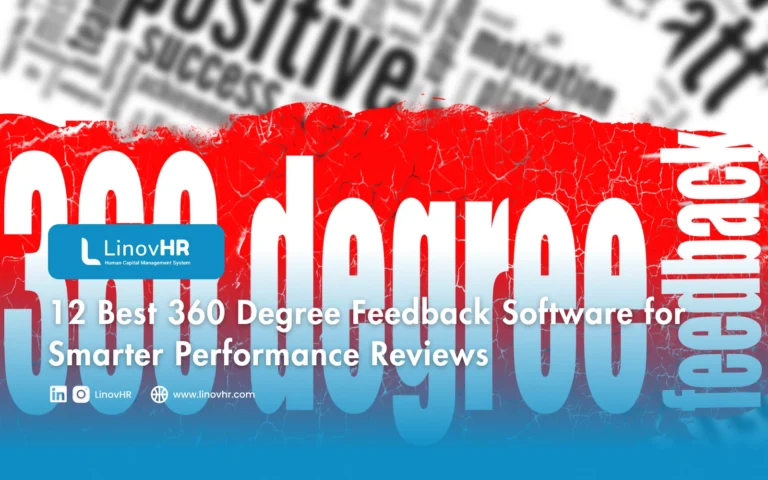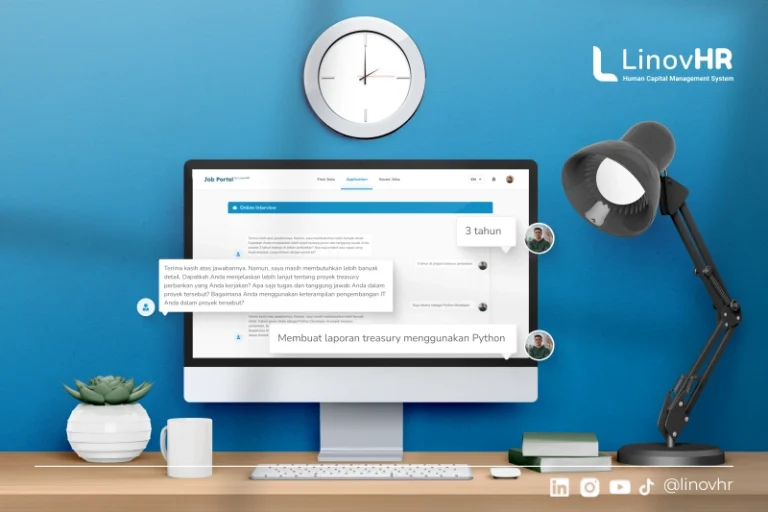In today’s rapidly evolving workplace, performance reviews are no longer just about what employees achieve but how they achieve it.
Companies are increasingly recognizing the need for more well-rounded feedback that captures multiple perspectives rather than relying solely on a manager’s evaluation.
This is where 360 Degree Feedback Software plays a vital role. By gathering input from peers, subordinates, managers, and even clients, it provides a complete and unbiased picture of an employee’s performance.
The insights gained not only support individual growth but also help organizations build a culture of transparency, collaboration, and continuous improvement.
What Is 360 Degree Feedback?
360 Degree Feedback is a performance evaluation method that collects feedback about an employee from multiple sources, including supervisors, peers, subordinates, and sometimes even clients.
Unlike traditional reviews that rely solely on a manager’s perspective, this approach provides a comprehensive and balanced view of an employee’s strengths, weaknesses, and overall behavior in the workplace.
This multi-rater feedback method helps identify not only what employees achieve but also how they interact and collaborate with others.
It emphasizes soft skills such as communication, leadership, teamwork, and adaptability all of which are crucial for long-term professional success.
For organizations, 360-degree feedback offers valuable insights into the effectiveness of leadership styles, team dynamics, and employee engagement.
However, it’s important to manage the process carefully. Without proper tools or structure, feedback can become inconsistent, biased, or difficult to analyze.
That’s why many companies now rely on dedicated 360 Degree Feedback Software to automate, organize, and analyze responses efficiently, ensuring fairness and data accuracy throughout the evaluation process.
Also Read: Performance Appraisal: Definition, Benefits, and Implementation Process
Implementing 360-degree feedback manually can be time-consuming and prone to bias. With automated 360 Degree Feedback Software, companies can streamline the process, from collecting responses to generating insightful reports, ensuring that evaluation is consistent, confidential, and data-driven.
These tools also make it easier for HR teams and managers to identify performance gaps, track employee growth, and create personalized development plans.
By leveraging technology, organizations can foster a culture of transparency and continuous improvement that enhances both individual and team performance.
Key Features to Look for in 360 Degree Feedback Software
When choosing the right 360 Degree Feedback Software, organizations must look beyond just collecting responses. The best tools help HR teams turn feedback into actionable insights that drive employee growth, improve communication, and foster a culture of continuous learning.
Here are the essential features to look for when selecting a solution.
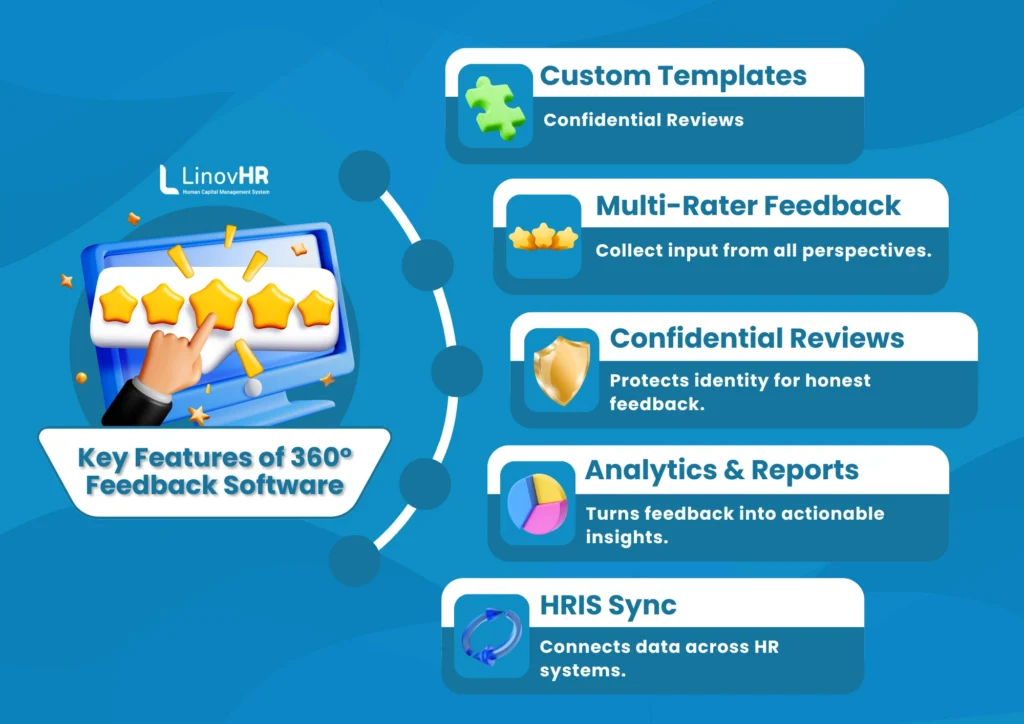
1. Customizable Feedback Templates
Every organization has different performance goals and competency frameworks, which is why customizable templates are essential.
A strong 360 feedback tool allows HR professionals to design questions and evaluation forms that fit the company’s culture, job levels, and leadership standards. This ensures that feedback remains highly relevant to each role rather than relying on generic questions.
Additionally, the ability to modify scales, wording, and competency categories make it easier for managers to focus on specific improvement areas.
By tailoring the forms to align with organizational objectives, companies can gather feedback that accurately reflects the skills and behaviors most critical to success.
2. Multi-Rater Feedback Collection
The true value of 360-degree feedback lies in multi-source input. Effective software allows companies to collect evaluations not just from supervisors, but also from peers, subordinates, and even external clients.
This comprehensive view provides a well-rounded picture of an employee’s performance and interpersonal dynamics.
With automation, the system handles invitations, reminders, and submission tracking, saving HR teams countless administrative hours.
More importantly, multi-rater feedback helps reduce bias from a single evaluator, providing a fairer and more accurate assessment of each employee’s competencies.
3. Confidential and Anonymous Responses
Psychological safety is key in feedback collection. Employees are more likely to provide honest and constructive feedback if they know their responses are confidential.
Leading 360 feedback platforms ensure anonymity by securely managing data and separating identity information from survey results.
This anonymity not only encourages more authentic feedback but also helps build trust across teams. Over time, it fosters a culture where employees feel comfortable sharing opinions, knowing their insights will be valued and used for growth rather than criticism.
4. Data Analytics and Reporting
Comprehensive analytics is what transforms 360 feedback data into actionable strategies. Top platforms include real-time dashboards and visualized reports that make it easy for HR leaders and managers to interpret performance patterns.
These analytics can highlight strengths, recurring issues, and areas that need targeted development.
Some advanced systems even offer comparative analysis and trend tracking, allowing organizations to monitor employee progress over multiple review cycles.
With clear and data-driven insights, leadership can make informed decisions about promotions, training programs, and performance improvement initiatives.
5. Integration with HRIS and Performance Systems
Integration is a crucial feature that ensures all HR processes stay connected. When 360 feedback software integrates with HRIS, performance management, and learning systems, it centralizes data for easier access and tracking.
This integration helps HR teams align feedback insights with other employee data, such as training history or goal achievements.
Furthermore, integration eliminates manual data transfer and reduces the risk of inconsistencies or errors. By having a unified HR ecosystem, companies can create a more seamless employee evaluation and development process, from feedback collection to performance planning and learning management.
12 Best 360 Degree Feedback Software Tools You Should Know
Choosing the right 360 Degree Feedback software is essential for organizations aiming to build a culture of continuous improvement. These tools streamline the feedback process, provide actionable insights, and help HR teams make informed decisions.
Below are twelve of the best 360 Degree Feedback Software tools that enhance performance reviews and foster meaningful employee development.
Also Read: Best Appraisal Software 2025: Definition, Features, and Top Recommendations
1. LinovHR
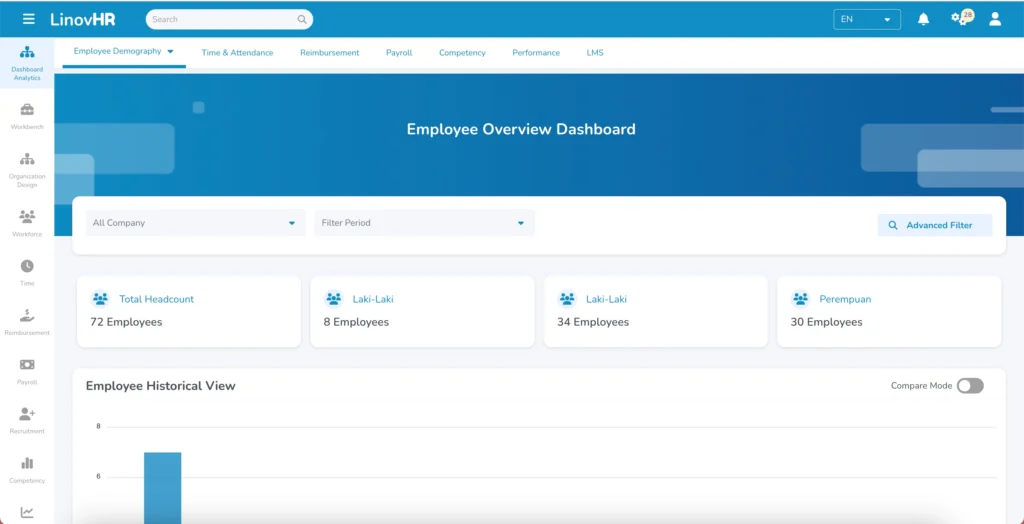
LinovHR is a comprehensive HRIS platform designed to simplify and automate every aspect of human resource management, tailored specifically for businesses in Southeast Asia, particularly Indonesia.
360 Degree Feedback module allows organizations to gather performance insights not just from supervisors but also from peers, subordinates, and even external collaborations. This multi-dimensional approach provides a more balanced and holistic view of employee performance, collaboration, and workplace impact.
What sets LinovHR apart is its seamless integration across all HR functions recruitment, attendance, performance management, training, and payroll, allowing companies to link feedback data with broader HR metrics.
For example, HR managers can correlate 360 feedback scores with employee engagement levels or training outcomes, helping them identify skill gaps or leadership potential with greater accuracy.
This integrated ecosystem transforms feedback into actionable insights that directly support employee growth and organizational strategy.
The platform also includes customizable dashboards that visualize feedback results in real time. HR teams can easily detect recurring themes, performance trends, and development opportunities across departments.
LinovHR’s user-friendly interface ensures that even non-technical users can conduct and analyze 360 feedback cycles efficiently.
With strong local compliance support, adaptable feedback workflows, and responsive customer service, LinovHR is an ideal solution for organizations looking to modernize their performance review process with a regional edge.
| Pros | Cons |
| Fully integrated with other HR modules (performance, payroll, training, attendance) | Some advanced analytics features are optimized for existing LinovHR users |
| Real-time dashboards and customizable visual reports | Initial setup may require training and configuration for large-scale use |
| Tailored for the Southeast Asian market with local compliance support | Primarily localized for indonesia global companies may need extra customization |
| Highly flexible feedback forms that adapts to different departments or job levels | |
| Provides analytical insights beyond static reports | |
| Easy-to-use interface suitable for non-technical HR professionals | |
| Responsive local customer support with regional expertise |
2. SurveySparrow
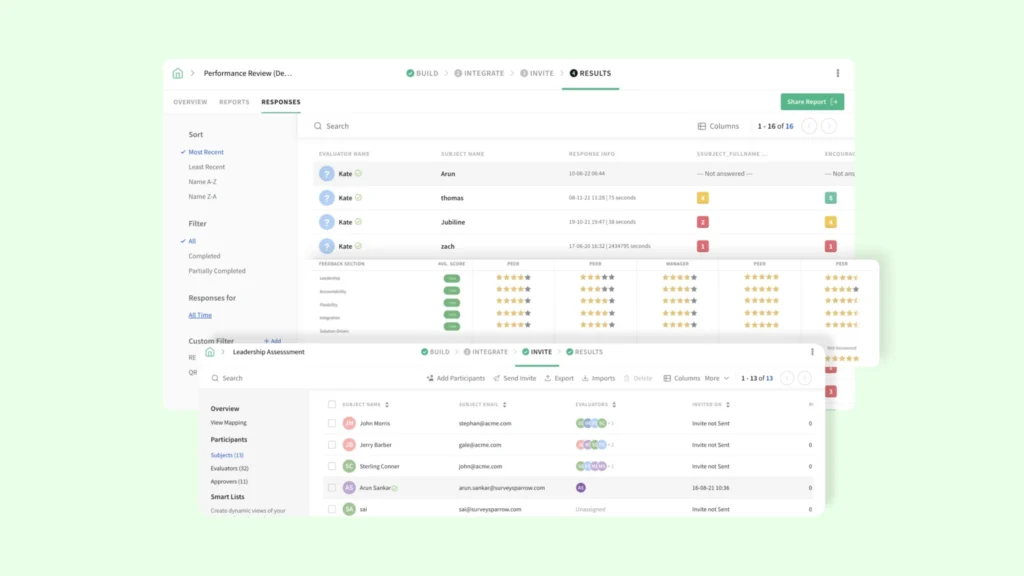
SurveySparrow is a modern, conversational survey and feedback platform designed to make 360-degree feedback engaging and easy to complete.
Its interactive and chat-like interface encourages employees to share honest feedback, improving response rates and data accuracy.
HR professionals can design customizable feedback forms that capture insights from peers, managers, and subordinates, enabling well-rounded performance evaluations across teams.
The software also provides automated feedback cycles, ensuring continuous performance tracking rather than once-a-year reviews. With its strong analytics dashboard, SurveySparrow helps HR teams analyze qualitative and quantitative data effectively, identify strengths, development needs, and engagement trends.
The platform also integrates with common HR tools such as Slack, Microsoft Teams, and Google Workspace, making it easy to collect and manage data in existing workflows.
In addition, SurveySparrow supports advanced reporting features, including sentiment analysis and graphical data visualization.
These tools allow HR professionals to dig deeper into employee feedback and understand behavioral patterns across the organizations. Its mobile-friendly design makes it accessible anywhere, allowing employees to provide feedback on the go.
With its balance of user experience, automation, and analytics, SurveySparrow is ideal for companies that want to create a continuous, engaging feedback culture.
| Pros | Cons |
| Highly engaging, conversational survey interface improves participation rates. | Advanced analytics features are available only on higher pricing tiers |
| Easy integration with collaboration tools like Slack and Microsoft Teams | Limited offline functionality for remote environments without internet access |
| Support automated feedback cycles and recurring surveys | May require customization for complex HR performance models |
3. Culture Amp

Culture Amp is one of the most popular employee experience and 360-degree feedback platforms used by global organizations to build stronger, data-driven cultures. It combines employee feedback, performance management, and engagement analytics into one cohesive solution.
With Culture Amp, HR teams can design customizable 360 feedback surveys, gather peer insights, and track performance growth across all organizational levels.
The platform’s biggest strength lies in its powerful analytics and benchmarking features. Culture Amp provides comparative insights across industries, allowing HR leaders to measure their company’s culture and performance against global standards.
Its AI-powered sentiment analysis helps uncover underlying employee concerns, making it easier to design targeted action plans. Managers can also access personalized coaching tips based on feedback data to improve leadership effectiveness.
| Pros | Cons |
| Offers comprehensive 360 feedback, engagement, and performance management features | Higher cost compared to basic feedback tools |
| Provides benchmarking data and AI-powered sentiment analysis | May require time to configure surveys for large organizations |
| Integrates well with major HR systems like Workday and BambooHR | Advanced reporting can be complex for first-time users. |
4. Qualtrics
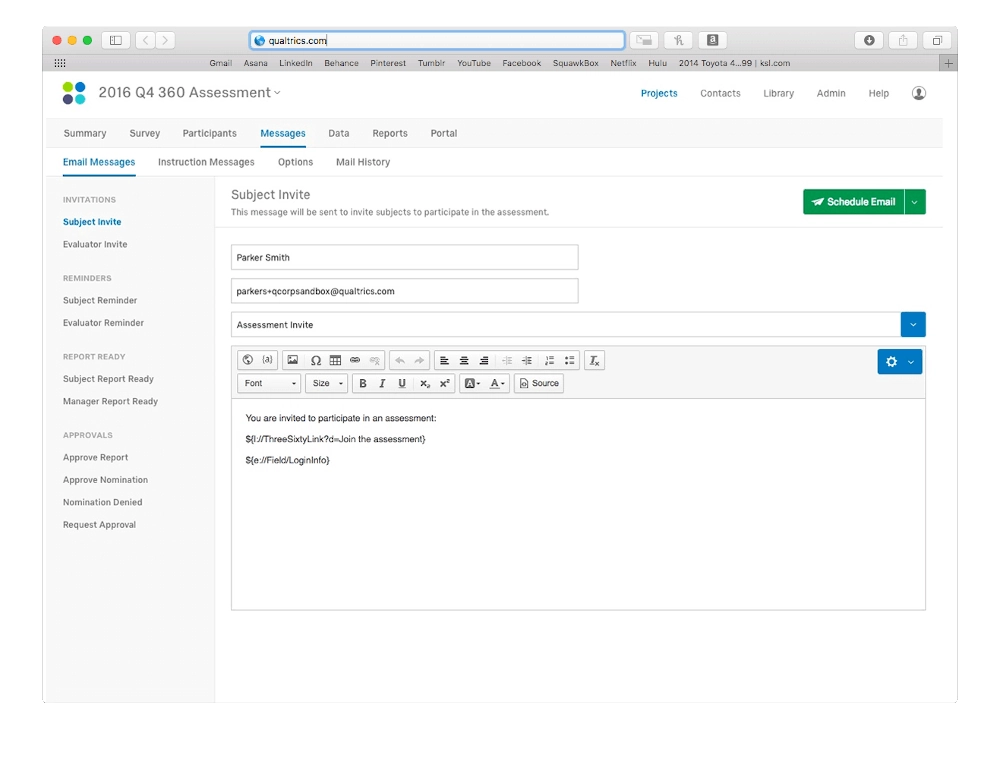
Qualtrics is a global leader in experience management and feedback analytics, offering one of the most robust 360-degree feedback solutions for enterprises.
The platform allows organizations to collect, analyze, and act on employee feedback at every level, helping HR leaders make informed decisions about performance, engagement, and development.
With Qualtrics 360, companies can easily create customized feedback forms tailored to different roles and leadership levels. The software provides automated reminders, anonymous participation options, and in-depth analytics dashboards that visualize performance trends over time.
Its AI-powered text analysis identifies patterns in open-ended responses, uncovering insights that might otherwise go unnoticed.
Another major advantage of Qualtrics is its integration with other business systems, such as SAP SuccessFactors, Microsoft Teams, and Slack, which helps streamline data collection and reporting.
It also offers benchmarking capabilities, allowing HR teams to compare internal results with external industry data. Qualtrics is especially valuable for large organizations seeking to build a data-driven culture of continuous feedback and employee growth.
| Pros | Cons |
| Extremely customizable 360 feedback templates and analytics dashboards | Complex interface may require training for new users |
| AI-powered sentiment and text analysis for deeper insights | Higher cost compared to small and mid-sized platforms |
| Strong integrations with SAP SuccessFactors and other enterprise tools | Can feel overwhelming for smaller teams or simpler feedback needs |
5. Spidergap

Spidergap is a specialized 360-degree feedback software designed to simplify performance reviews and development planning for teams of all sizes. It focuses on creating a positive feedback experience for both reviewers and employees, encouraging constructive discussions and measurable growth.
The platform’s intuitive interface makes it easy to launch surveys, track responses, and deliver personalized reports without technical complexity.
One of Spidergap’s biggest strengths is its ready-to-use templates that help HR teams quickly set up feedback cycles aligned with leadership competencies or company values.
The system automatically generates visual development reports, which highlight an employee’s top strengths and key improvement areas, making it easier for managers to design effective action plans.
Spidergap also supports multi-language surveys and provides real-time analytics dashboards that help HR leaders monitor participation rates and overall engagement.
Its focus on employee development rather than evaluations makes it an ideal choice for organizations that want to foster a growth-oriented culture.
| Pros | Cons |
| User-friendly and quick setup with customizable templates | Limited advanced analytics compared to enterprise tools |
| Great for creating actionable development reports | Lacks deeper integrations with some HR systems |
| Multi-language support ideal for global teams | Reporting design is somewhere basic not for large organizations |
6. Engagedly

Engagedly is a performance management and employee engagement platform that offers powerful 360-degree feedback tools to help organizations foster continuous development and recognition.
Its feedback systems enable employees to give and receive input from peers, managers, and direct reports promoting a culture of transparency and growth. The platform supports competency-based feedback templates, making evaluations fair, structured, and aligned with company values.
What sets Engagedly apart is its blend of performance management, learning, and engagement features. Beyond 360 feedback, it includes OKR tracking, and goal teams build a data-driven performance culture.
Its user-friendly dashboard makes it easy for managers and employees to navigate, track progress, and visualize performance insights in real-time.
Engagedly also integrates with popular workplace tools like Slack, Microsoft Teams, and Google Workspace, ensuring seamless collaboration and accessibility.
Its flexibility and modular design make it suitable for both small businesses and large enterprises looking to modernize performance management.
| Pros | Cons |
| Comprehensive suite combining feedback, goals, and engagement | Limited advanced analytics compared to enterprise platforms |
| Intuitive interface and easy-to-use design. | Customization can be limited in lower-tier plans |
| Strong integration with collaboration tools like Slack and Teams | May require onboarding for users unfamiliar with HR software |
7. PeopleGoal
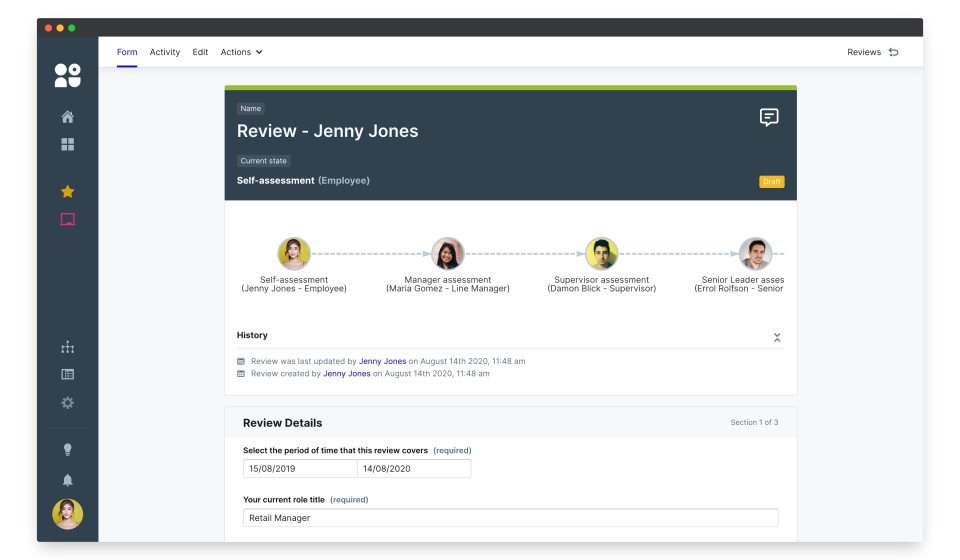
PeopleGoal offers a highly configurable 360-degree feedback solution, designed to fit how modern teams actually work.
The platform allows HR teams to build custom feedback workflows, define which peers, managers, or external collaborators provide input, and automate the entire cycle from invitation through reminders to reporting.
This flexibility ensures the feedback process aligns with real organizational structures, whether hierarchical, cross-functional, or project-based.
Beyond workflow, PeopleGoal emphasizes competency and role-based feedback. Users can benchmark skills (e.g., communication, leadership, teamwork) with weighted ratings that reflect what matters most for each role or team.
The platform also supports anonymous feedback collection, making it easier for participants to be candid without concern for attribution.
Reporting and insights are another strong point: PeopleGoal allows HR to filter, export, and visualize feedback at individual, team, or departmental levels.
With dashboard and analytics, HR can spot patterns of strengths and gaps across the workforce, enabling targeted development efforts and more strategic performance discussions.
| Pros | Cons |
| Highly customizable 360 feedback workflows and templates | Some users report customer support responsiveness as a challenge |
| Strong benchmarking and role-based competency scoring | Integrations may require more setup for complex HR ecosystems |
| Anonymous feedback option and strong reporting/export capabilities | Some features may be less polished compared to enterprise-only systems |
8. PerformYard
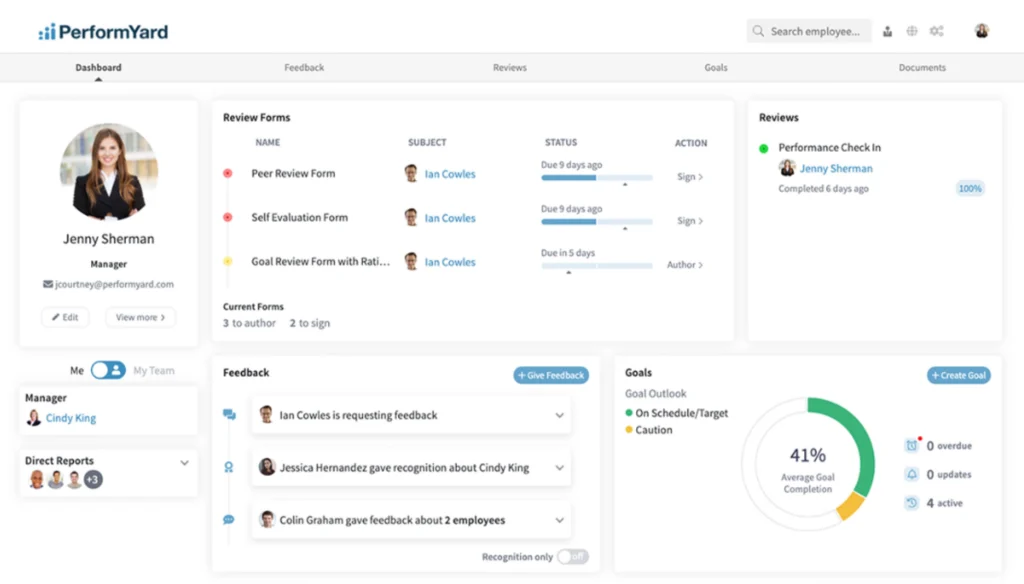
PerformYard delivers a streamlined and efficient 360-degree feedback experience tailored to organizations that want simplicity without sacrificing depth.
It enables HR professionals to collect structured feedback from peers, subordinates, and managers through customizable forms and workflows. The platform focuses on creating clarity and accountability, ensuring every participant knows their role in the evaluation process.
The tool provides centralized performance data and feedback in one accessible dashboard. Managers can easily review employee progress, compare results across teams, and track goals alongside feedback insights.
This integration between 360 feedback and goal tracking gives HR leaders a clear, holistic view of employee performance, making it easier to plan reviews, promotions, or development discussions.
PerformYard also stands out for its reporting and automation features. HR teams can automate reminders, define review cycles, and generate data-driven reports that highlight trends and development opportunities.
With strong customer support and intuitive UI, it’s a practical choice for organizations looking to elevate performance review without overcomplicating the process.
| Pros | Cons |
| Intuitive and user-friendly interface suitable for non-technical users | Limited third-party integrations compared larger HR suites |
| Excellent automation tools for reminders and review cycles | Customization options may be basic for high complex feedback models |
| Seamless link between feedback, goal management, and performance data | Reporting can feel limited without upgrading higher pricing tiers |
9. SurveyMonkey
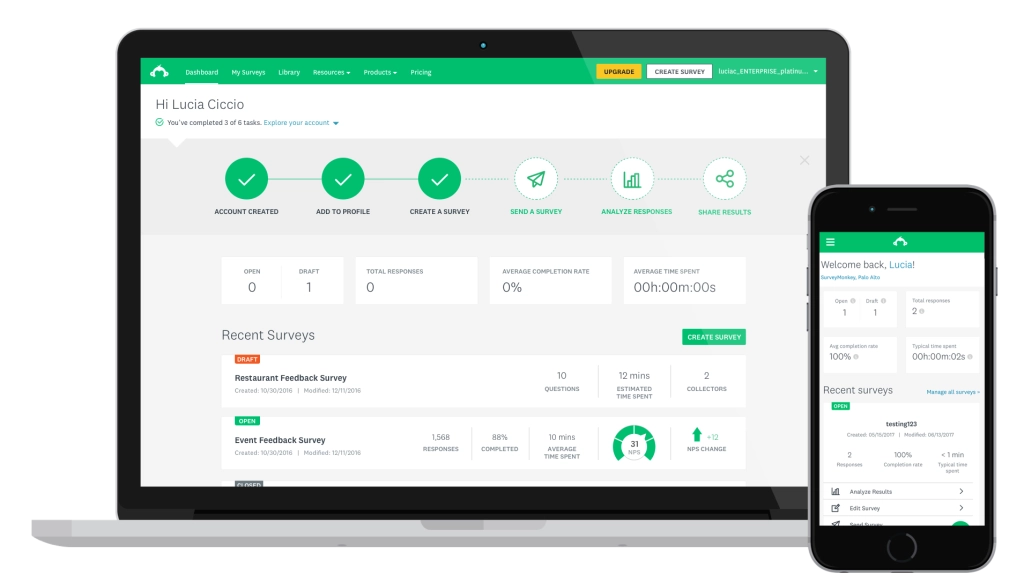
SurveyMonkey is a popular online survey platform that can be easily adapted for 360-degree feedback. It provides ready-to-use templates, anonymous survey options, and flexible distribution via email or web links.
HR teams can gather multi-rater feedback from managers, peers, and subordinates to gain insights into employee performance and development needs.
The platform’s AI-assisted survey design, built-in analytics, and integrations make it a versatile tool for organizations seeking simple yet effective ways to collect feedback.
While not built exclusively for HR performance management, its customization option and scalability make it a practical choice for companies already familiar with survey tools.
| Pros | Cons |
| Easy-to-use and widely recognized platform | Lacks specialized 360-feedback features |
| Offer ready-made templates and high customization | Limited HR-specific analytics and reporting |
| Integrates with 200+ tools for flexible usage | Requires add-ons for advanced HR function |
10. Leapsome
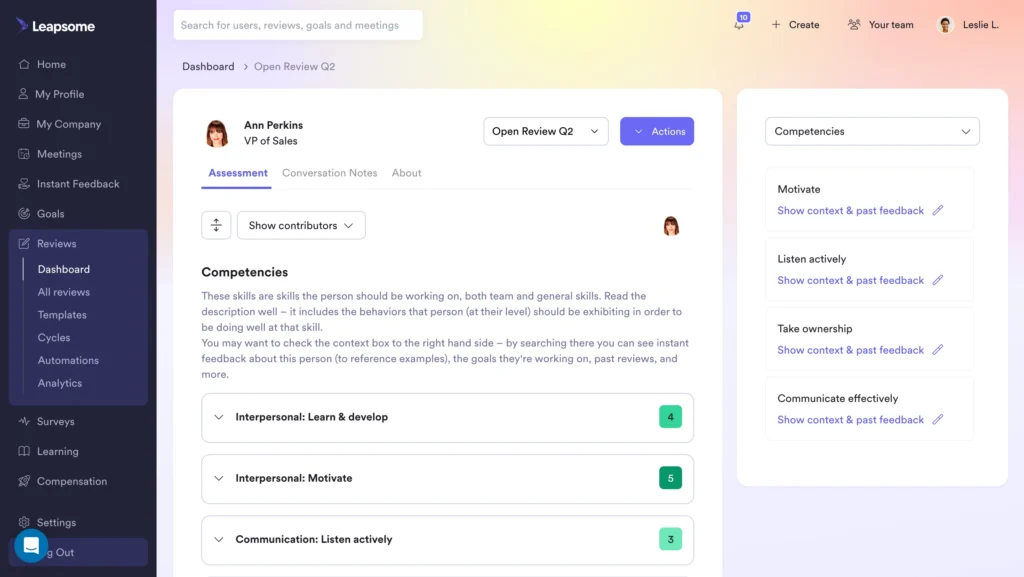
Leapsome is an all-in-one people enablement platform designed to streamline performance review, employee engagement, learning, and 360-degree feedback.
Its 360 Feedback module allows HR teams to collect structured feedback from multiple sources, peers, managers, and direct reports offering a holistic view of employee performance and development opportunities.
The platform also includes powerful analytics and personalized learning recommendations, helping organizations align feedback results with actionable growth plans.
With automation features, intuitive UX, and robust reporting, Leapsome enables companies to build a continuous feedback culture that supports both performance and engagement.
| Pros | Cons |
| Combines feedback, performance, and learning tools in one system | Can be costly for small teams |
| Offers automation for review cycles and reminders | Some users find setup and customization complex |
| Delivers actionable insights with detailed analytics | Limited offline accessibility |
11. Rippling
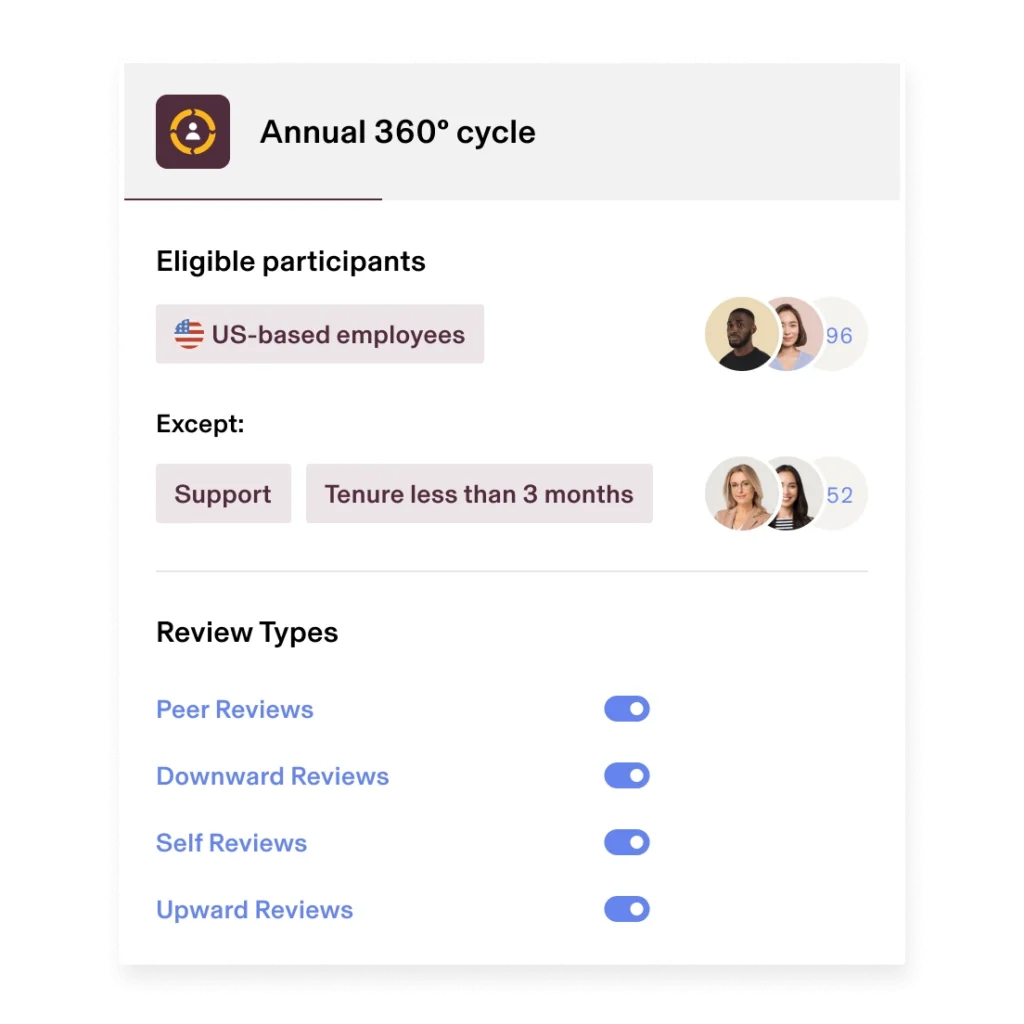
Rippling is an all-in-one HR, payroll, and workforce management platform that includes a robust module for 360-degree feedback embedded within its performance management suite.
The software supports multi-rater cycles employees can invite peers, direct reports, managers (and in some cases external stakeholders) to provide feedback, creating a holistic view of how the individual performs across relationships and contexts.
The power of Rippling lies in its unified data platform: since all employee data (performance, goals, payroll, HRIS data) lives in the same system, feedback results can be correlated with other workforce data to uncover deeper insights.
For example, HR can analyze how 360-feedback scores align with goal achievement, turnover risk, or training participation.
Besides cyclical feedback, Rippling offers automation for “what-if” review cycle, continuous feedback options, and review calibration features.
This means HR teams can set up review workflows with custom reviewer groups, automated reminders, and consistent feedback designs, facilitating scalability across large and dynamic organizations.
| Pros | Cons |
| Built on a unified HR data platform enabling deep insight and correlation across modules | Pricing and licensing may become expensive for smaller organizations |
| Robust 360 feedback workflows, including peer nomination, custom reviewer groups, and automated review cycles | Implementation and adoption can be complex given the breadth of features |
| Integrated performance, goals, feedback, and HRIS data in one system for streamlined analytics | Some users report challenges with customer support or onboarding in global contexts |
12. iSpring Learn
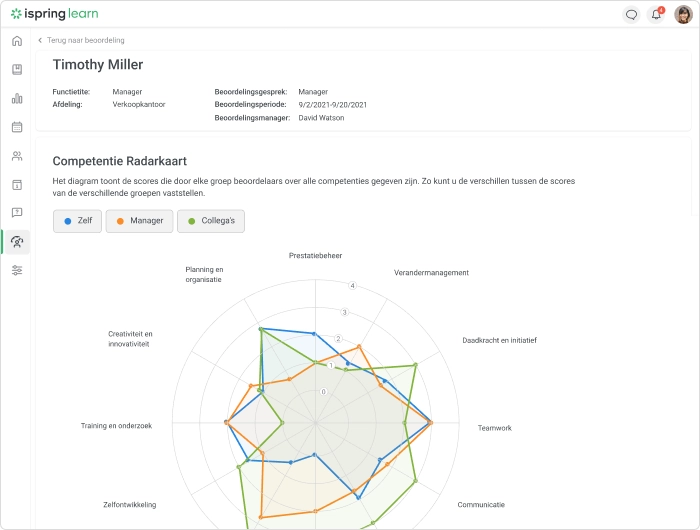
iSpring Learn is a powerful Learning Management System (LMS) that includes integrated performance and 360-degree feedback tools, helping organizations evaluate employees comprehensively.
With its 360-feedback feature, managers can gather insights from peers, supervisors, and direct reports, providing a clear view of employee strengths and development areas.
The platform’s strength lies in its seamless integration between learning and feedback. After each review cycle, HR teams can assign targeted learning paths based on feedback results ensuring continuous growth and measurable performance improvement.
iSpring Learn’s analytics dashboard visualizes trends and progress, making it easier for managers to track development over time.
Furthermore, iSpring Learn offers a clean, user-friendly interface and mobile accessibility, making feedback and learning available anytime, anywhere. Its automation tools simplify scheduling, reminders, and report generation, freeing HR professionals from repetitive manual work.
| Pros | Cons |
| Integrates 360 feedback directly with learning modules for continuous growth | Limited customizations in feedback templates |
| Easy to use with a clean and intuitive interface | Reporting can be basic compared to advanced analytics tools |
| Strong automation and mobile support for remote teams | Focuses more on learning than advanced performance analytics |
Optimize Your Feedback Process with LinovHR’s 360 Degree Feedback
In today’s dynamic workplace, organizations need more than just traditional performance reviews; they need a complete understanding of how employees contribute, collaborate, and grow.
LinovHR’s 360 Degree Feedback module offers a powerful solution to achieve that. By gathering feedback from multiple perspectives managers, peers, subordinates, and even external partners it provides a well-rounded and objective view of each employee’s performance.
With LinovHR, HR professionals can easily customize feedback forms, automate review cycles, and generate insightful reports that highlight key strengths and development opportunities.
The system integrates seamlessly with other LinovHR modules such as Performance Management and Learning Management, enabling a holistic approach to talent development and continuous improvement.
Implementing LinovHR’s 360 Degree Feedback helps organizations build a culture of openness, accountability, and growth. Empower your teams with transparent evaluations and actionable insights to enhance performance and engagement.
Request a free demo today and discover how LinovHR can optimize your feedback process for a more productive and motivated workforce.


